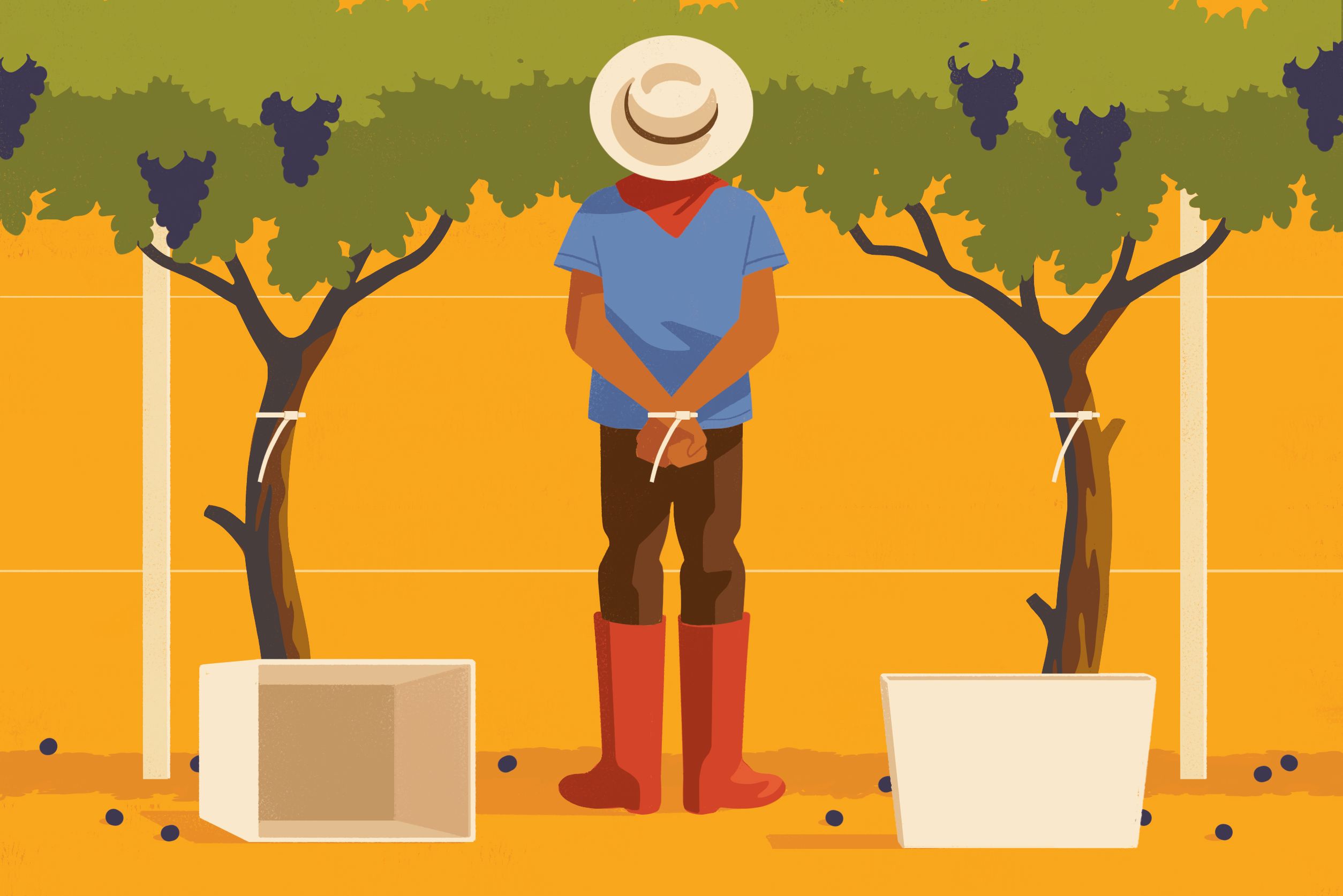4 Portland Photographers on Covering the BLM Protests
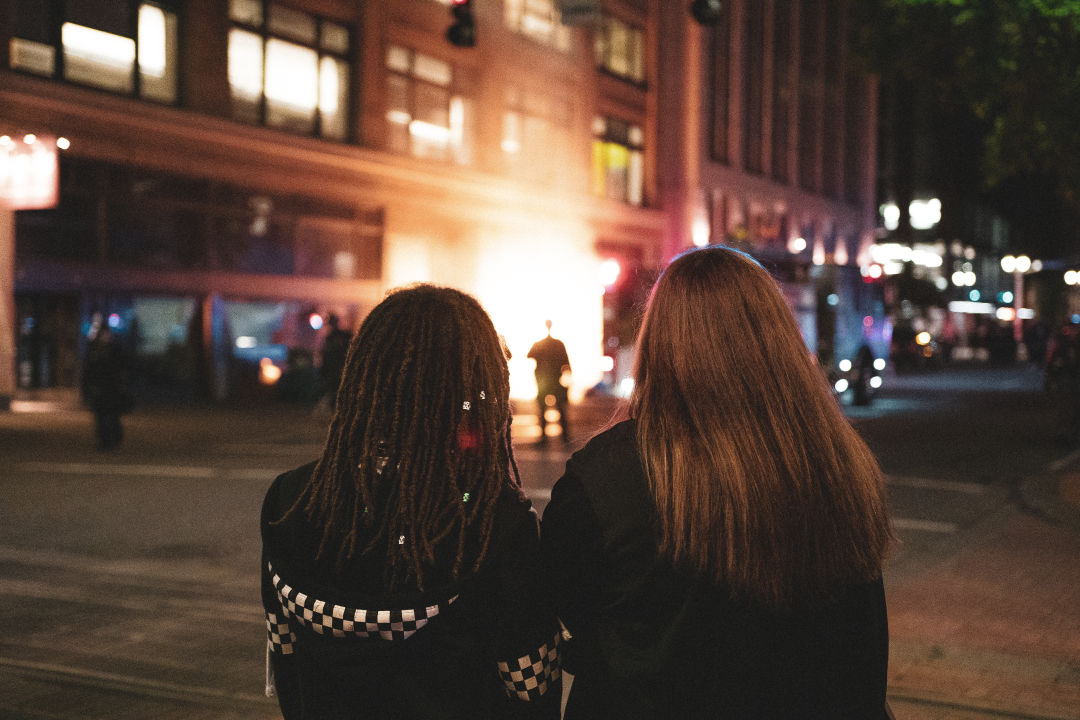
Joseph Blake Jr. has been documenting the protests on the ground and in the air (with a drone).
Image: Joseph Blake Jr.
Protest coverage is the siren’s song of photojournalists.
We simply cannot resist the urge to capture the fire and fury, the swinging batons, and exploding tear gas canisters, can’t wait to live-tweet the event like it's a sport, make a pithy observation or two, get a couple dozen new followers, take a photo of someone washing their eyes out with milk, sling that shit on Instagram, and watch the little hearts stack up. (I’m not absolved here, either.) As journalists and photojournalists, we need to reexamine the ways in which we shape these narratives.
The country now enters almost a month of protests in response to police violence and systemic oppression, and several months of fighting COVID-19 which has disproportionately affected Black and Brown communities, begging the question: who is telling this story? Just as industries across the nation are reshaping their cores to be inclusive, the old guards of journalism and the idea of neutral objectivity are being questioned—and rightfully so. Organizations such as The Photo Bill of Rights, The Everyday Projects, and others are offering lens-based workers guides to covering the current Black Lives Matter protests and the far-reaching effects of COVID-19 in a way that’s more inclusive and transparent.
What’s happening on the streets, however, is not simply what we see on the front pages of our favorite publications. There are hundreds of independent and contract photographers and videographers aiming to tell these stories through their lenses. Portland Monthly spoke with a few to learn about what they’re seeing on the ground and how they are navigating the ethical landscape of protest coverage.
Mariah Harris
Save for one or two days, Mariah Harris has been marching with the movement since the beginning. Between photographing the protests and working graveyard shifts for her full-time job, these last few weeks have been exhausting for Harris. But she approaches each day with energy and an intention to tell this story.
Harris's background is in portrait photography, creating life-long memories for couples and families. Photography had always been around, though. Growing up, she remembers owning various point and shoots, but a few years ago, amid a bout of depression, Harris picked up the camera and started honing her craft. Full steam ahead, she started working with couples and families, invested in a new camera, and started working on her photography business, Moments by Mariah.
As the protests gained momentum, Harris’s portrait photography shifted into photojournalism. But her background gives her photos clarity and honesty, showcasing the soul of this movement as much as the story.
“It was something I knew I had to do. It’s something that was a call. I was like, ‘I need to answer this. I need to tell this story through our eyes.’ I’d say on day five or so is when I was realizing that we may be in this for the long haul. One of the speakers talked about how it’s typical that when a person gets killed by police brutality, we end up doing protests for maybe a couple of days and then we go back to normalcy. And that’s actually what I was kind of expecting. It’s kind of what we do. Rinse and repeat. But this—people are fed up, man. I mean, I’ve been fed up, too. So now that I have this passion with this camera, it all just aligns for me to answer this and tell this story. I just jumped and the net appeared.
“I feel like when other people tell my story it’s disrespectful and insulting. It’s like, you wouldn’t want that happening on your behalf. And that’s honestly what’s been happening for people of color all of our lives. I guess that’s why a lot of people are feeling very strongly with having another White narrative telling this story. I’m very pro any person of color telling this story. I’m like, ‘It’s your time, too.’ We all need to amplify. We all have been a minority all of our lives. We’re not trying to dismiss the White narrative—they’ve just been in control. We’re just trying to amplify what deserves to be told finally. Tackling White supremacy is obviously a very big alley, but this is an alley I can try to tackle. And I’m going to try and switch the narrative as best as I can.”
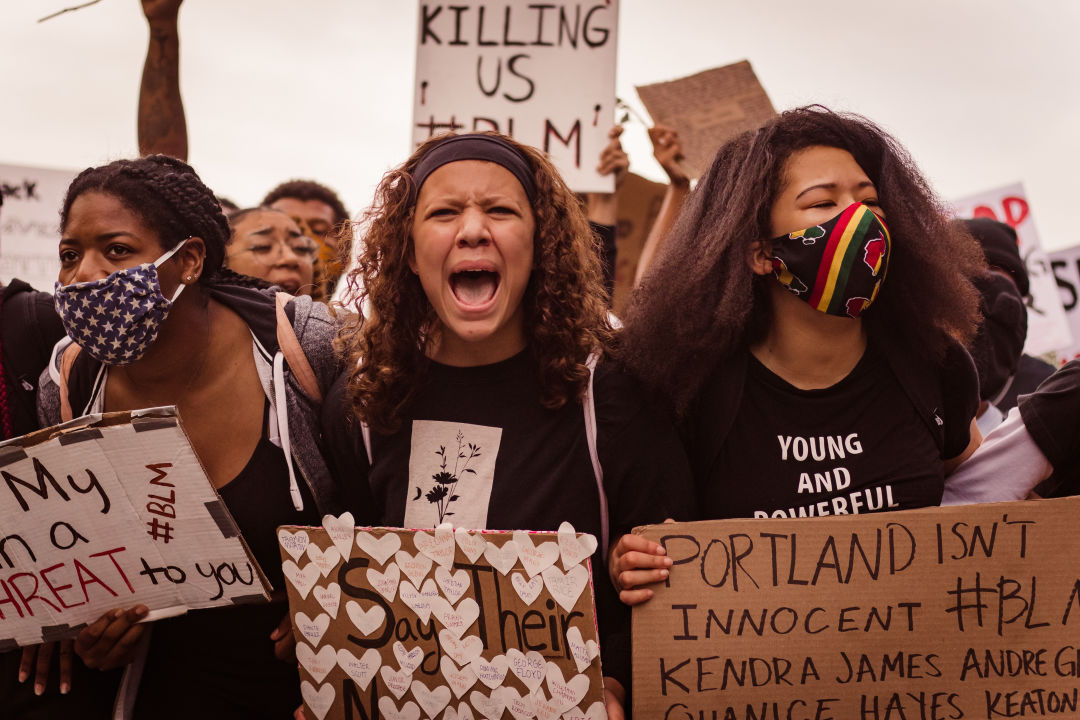
Image: Mariah Harris
Joseph Blake Jr.
Joseph Blake has been playing around with a camera since he was about 10. He’d make skits and funny videos with his friends, but in high school, Blake received his first DSLR, and he says there was something about that moment that made him take photography a lot more seriously. He began working on his craft and by the time he turned 18, Blake started to see himself as more than a photographer. He was beginning to see himself as an educator.
Five years later, amid a global pandemic and nationwide protests, he’s creating images and videos that are not only visually arresting for their raw depictions, but educational, providing context and personal history.
“I didn’t necessarily want to document [the protests] like how I’ve been doing. I just kind of came out to show my support and solidarity with the movement. But when I was there, I took a couple of pictures and I posted something about it and expressed my feelings about it, and I saw people getting a sense of my perspective on things, and they liked it and thanked me for it. I kind of saw that as a tool to bring awareness to the cause and to get more people to understand different perspectives and individuality within the Black community.
“The first day I came out here I got inspired. It was more than just me documenting this, it was also finding a piece of myself that I didn’t have before because I can finally speak about these issues and express myself in a way and not be told to be quiet, because people are realizing now that the stuff we’re saying is not dramatized. It’s real. It’s reality. So by me going out every night, I get to still be a part of this, and I just think that doing this is something bigger than myself."
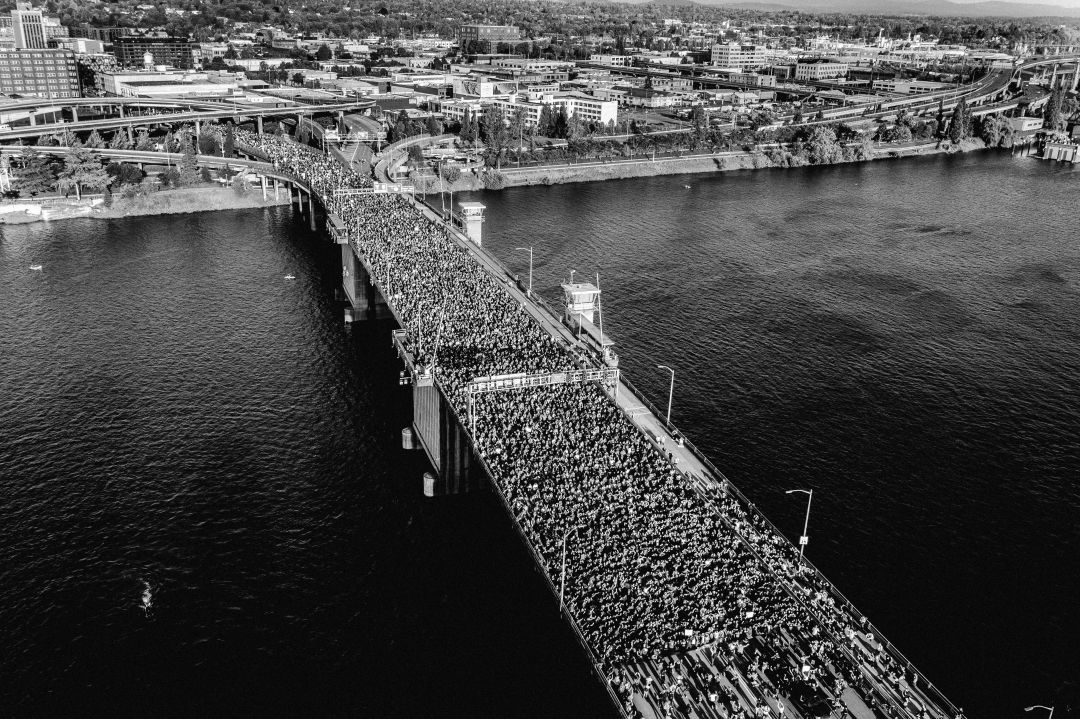
Image: Joseph Blake Jr.
Josué Rivas
Language, Josué Rivas says, is really important in the way that we’re making images right now. Taking, capturing, shooting. All those words and ideas come from colonial language. Instead of taking, Rivas might say, “I’m going to go make a photograph.” Instead of “You’re my subject,” he might say, “We’re collaborators.” He’s even started replacing the word photograph with portal, because, for Rivas, images are portals to a different dimension. And that dimension can be multidimensional by including the voice of the person in the photograph, he says.
Rivas’s portals during the Dakota Access pipeline protests in Standing Rock in 2016 and 2017 opened many doors, including a fellowship with the Magnum Foundation where he studied under acclaimed educator Fred Ritchin. But his photographic journey began as a young boy when he would deliver prints with his father. His father was a photographer, too, and dealt with alcohol abuse. But in those moments where his father would deliver portraits to people who couldn’t afford to pay him, Rivas says he realized that it was about more than a photograph. It was about building a relationship and respecting people’s dignity, a mark that remains true in Rivas's work now.
“We have to update the operating system of making images. We’re outdated as fuck. We’re still thinking that if it’s on the front page of the New York Times it’s real, and it’s truth. But there’s so much more to what we’re shown… There’s always a photo of a Brown person suffering. Low-key we’re told that Brown is inferior, and Black is inferior. And their suffering has been made for our consumption.
“The images we make right now and how we show up to places are like seeds. We’re planting the seeds. You can’t go and document this protest in Portland and not be mindful and thoughtful about how you are going to photograph a community that is not your community, a community that has been so fucking marginalized since the beginning of the States—there’s deep trauma there. We need to show up with seeds of healing and seeds of compassion and seeds of listening and literally trying to understand the Black experience. These photographs are seeds that are going to bear fruit that we will not get to see. So you have to be OK with knowing that, but that the future generations are going to see this moment in time. Fucking 2020 is going to be a thing in the future. People will say, ‘2020 was a year of change. 2020 was a year of abolition.’ And we won’t be there for that. But the images will be.
“Dignity. That’s what it comes down to. I saw the dignity in the people that my dad photographed, even though they’d just give us a plate of rice with some chicken and some mole and tortillas. But that was their way of saying ‘Thank you for seeing me.’ I want my kid to see how the image can be a tool for connection. I want him to remember to give back to the people instead of taking from them.”
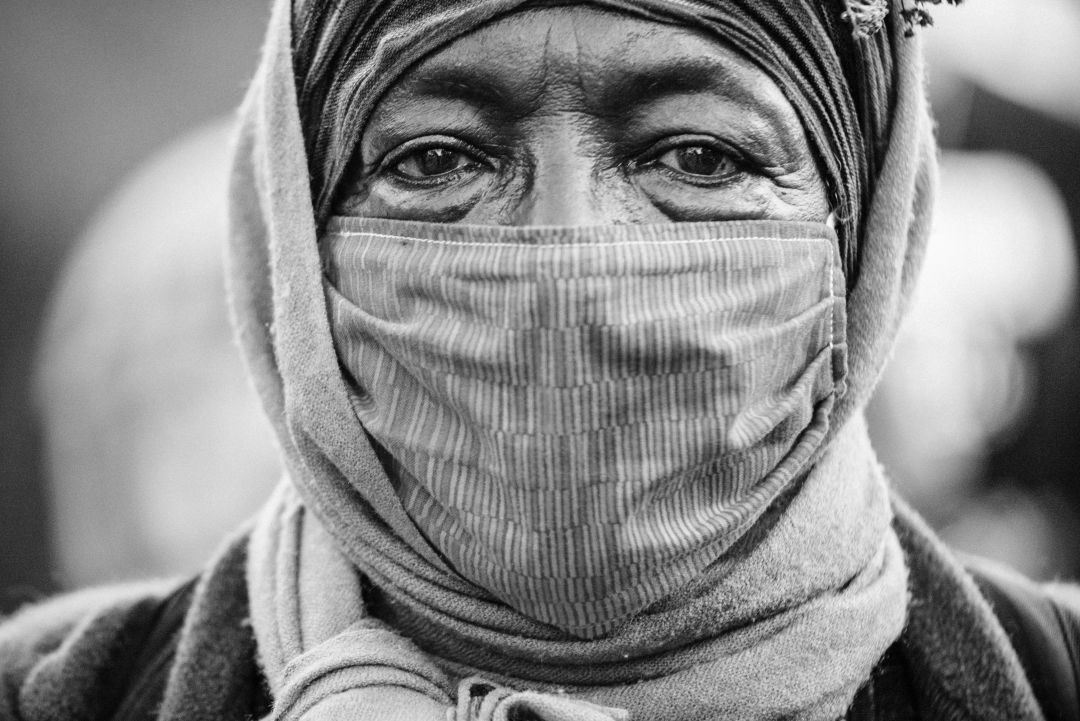
Image: Josué Rivas
Alex Wittwer
The press is a business. Alex Wittwer knows this. But taking inspiration from war photographer James Nachtwey, Wittwer is always in search of finding a balance between business and service. Wittwer tries to live by Nachtwey’s words: “Society's problems can't be solved until they're identified. On a higher plane, the press is a service industry, and the service it provides is awareness. Every story does not have to sell something. There's also a time to give.”
Wittwer spent his last semester at Portland State University as Photo Editor at Portland Vanguard, PSU’s student-run newspaper. Now, he’s working with Willamette Week as a freelance photojournalist, primarily covering the current wave of Black Lives Matter protests in Portland. His work attempts to highlight a broad view of the protests, showing us first the scope and magnitude, then honing in on faces and actions. What Wittwer manages to showcase is the complexity, fires raging and tear gas spewing, the power of kneeling protesters, the solidarity of a raised fist.
“What I’ve learned over the years is that there a lot of little stories inside of a bigger story, and the job is to tell those smaller stories in sequence so that you can paint the largest and most accurate picture of events as they happened.”
“You have to recognize those [ethical] traps, I think. Those biases that you have. I was talking to this guy who was at the protest. In the distance he spotted someone setting fire to a flag—and he’s a photographer, he had his camera with him—and he just bolted and went straight for it. I guess it’s kind of the story, but it reminded me of this photo I’d seen of protests in Eastern Europe where all the coverage was on this one street. Everything was on fire. There was this large protest, but everywhere else in town it was business as usual… [my goal is] to try and get the whole story. That way, when I do turn it in to my editor, they have more to piece it together.
“The protests always have a message. Either it’s a very articulated message with very specific demands, or it’s something a little looser, a way to show anguish or pain or resistance. The protests are there to send the message and journalists are there to amplify because we have that platform to spread that message further out."
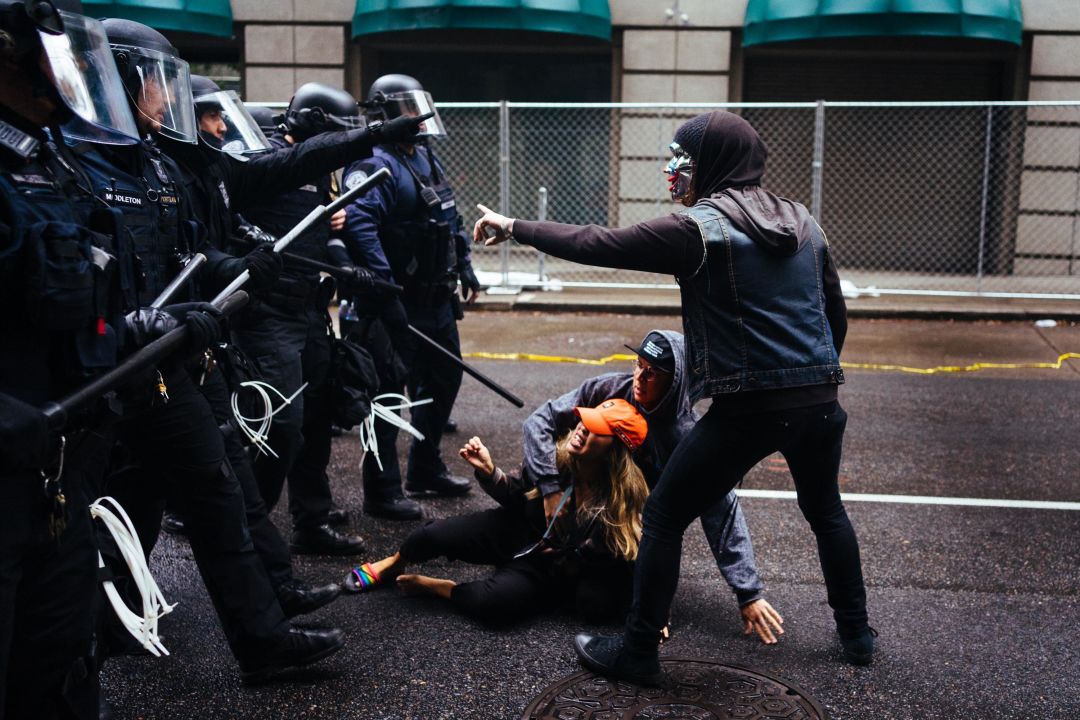
This photo was originally published in Willamette Week.
Image: Alex Wittwer



